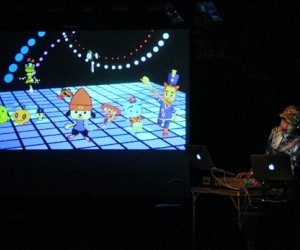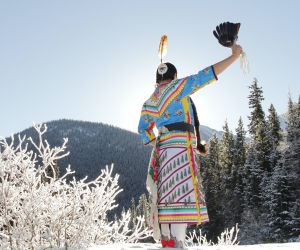
PHOTOGRAPHS BY GREEN YANG
Resonances are ghosts. They accentuate unseen presences of sounding bodies as they amplify frequencies inherent in them. Noted Italian composer Luciano Berio explored the transfer of energy from one body to another in his Sequenza X (1984), which requires a pianist to silently depress keys and pedals while a trumpeter blasts accented notes to activate resonance from the piano’s sounding body. The piano is forced to resonate at the expense of its own musical voice, which has been appropriated by the trumpeter.
The process of colonization is one of subjugation and has often resulted in a culture being displaced or even erased. Intriguing interactions may emerge in the transmission of cultures through resonances. However, problems arise when one culture displaces the other. Throughout history and for various reasons, composers have extracted traditional musics from cultures other than their own to use in their own work. This benefits the composer: the cultural source then either morphs into a commodity or remains hidden in the sidelines. Singer and composer Jeremy Dutcher’s 2018 album Wolastoqiyik Lintuwakonawa (2018) does the opposite, finding and reviving lost, hidden voices. Working with wax-cylinder recordings of his ancestors’ songs, Dutcher reanimates the songs of the Wolastoqiyik (people of the river) with new arrangements.
We need to ask, then: who controls a particular practice or sound? Who decides to preserve—or even dispose of—a song or a cultural object? Repatriation—the act of giving back things taken away—can happen, whether by returning physical objects or by surrendering inappropriate ownership of intangibles. Restoring disembodied voices requires the repatriation of their autonomy. My inquiries into these ideas led me to reflect that this kind of redressing has been long overdue within the spaces where we gather to discover music. Two Canadian music venues are currently confronting these ideas and have been triggering important conversations.
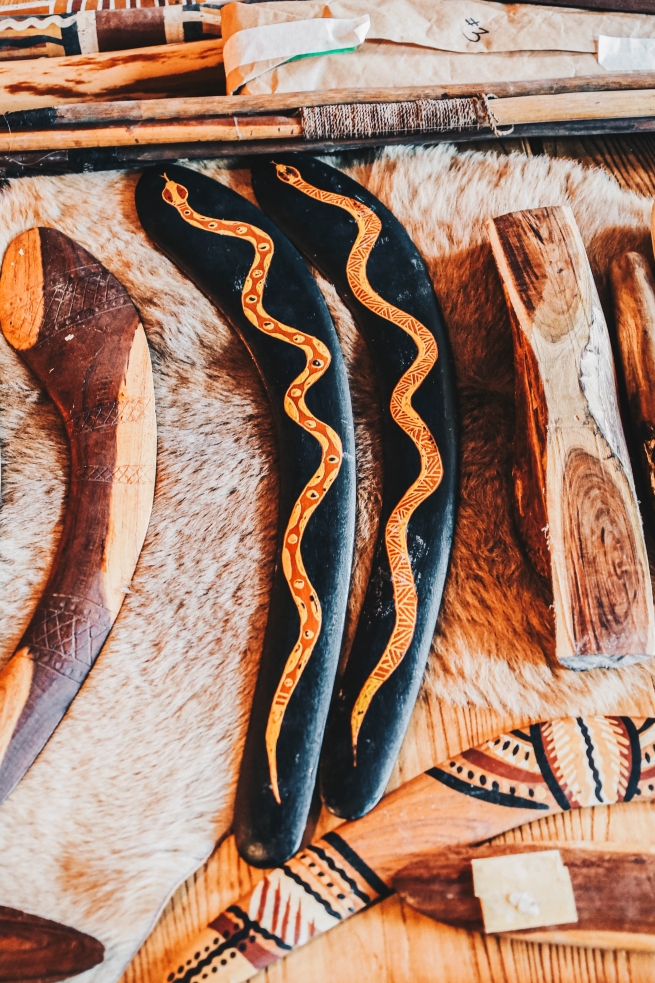
On a gloomy April morning in 2022, Toronto’s Annex neighbourhood rouses itself after a bustling night. I arrive at a two-storey grey building that sports a Pride flag on its front doors and snap a photo. A staff member greets me: “I saw you taking a photo, so I assume that this is your destination?”
The Toronto Australia New Zealand Club, familiarly known as the Tranzac, is a music venue and the home base of affiliates and arts organizations. Founded in 1931 as a social club for Australian and New Zealander immigrants, it has since been transformed into a welcoming, vibrant venue that hosts theatre, film, literary events, and live music.
I’ve been invited to the Tranzac to witness a special event. First, however, I am enlisted to help staff move boxes filled with items wrapped in brown paper from a cramped second-floor storage room down to the venue’s Southern Cross Lounge. As we unpack the items on a row of tables, a stunning collection of Aboriginal objects is revealed: boomerangs, bullroarers (sound makers for ceremonies and communication), a couple of didjeridu (called yidaki in other communities), tapping sticks (for ceremonies), wooden shields with intricate carvings, spears, and a collection of bark paintings bearing depictions of kangaroos, emus, and even Wandjina the Creator. Such tools and weapons are considered men’s business and women are not allowed to touch them; hence the need for my assistance.
A burly man wearing white ochre facial paint enters the premises not long after. Richard Scott-Moore, who also goes by the name of Goombine, is a lore man of weapons and tools from the Yuin Nation, located in the southeast coast of New South Wales. He and his family are the traditional landowners of a thousand-acre piece of ancestral land that houses a cultural centre, many sacred sites, and an ecosystem of diverse wildlife. His ties to First Nations in Canada are of a conjugal nature; he is married to Candace Scott-Moore, an Anishinaabe arts producer and a member of the Chippewas of Kettle and Stony Point First Nation in southwestern Ontario.
The Tranzac’s board of directors had invited Goombine to identify these objects, which had been stored for an estimated forty years without anyone knowing they were there. He was shocked to recognize them as belonging to his ancestral heritage, and after overcoming his emotions at seeing these valuable objects locked away, sought advice from Max Dulumunmun Harrison, his grandfather’s brother. “You know what you have to do,” he was told.
So now, a hastily arranged ceremony at the Tranzac—to which I have been invited—is about to be conducted to relinquish these objects to his care and launch their journey home. “I couldn’t sleep last night. I was like a little kid,” Goombine admits as we chat before the ceremony. “I thought about reuniting with my ancestors. These tools and weapons—they’re family, my sisters and brothers.” This reunion with ancestors is an affirmation of birthright and identity as they connect to the spirits, land, and lore surrounding these objects.
It is, I realize, unusual for a music venue to play a role in repatriation, which is an act the general public primarily associates with artifacts exhibited in the glass cases of a museum.
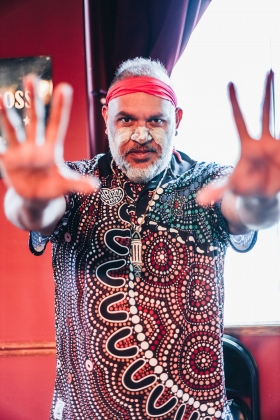
“It’s the cycle of how everything works, how we are all part of the earth,” opera singer Marion Newman was telling me. “I’m no better than the bears and eagles, nor are they better than me. We have the responsibility to give back to the earth as much as it gives us.” As Newman explained Awi’nakola—the Kwakwaka’wakw philosophy of living in balance with air, land, water, spirit worlds, and everything intermingled in them—Goombine’s sentiments around ancestral objects resonated for me.
Newman is a Kwagiulth and Stó:lō First Nation member with English, Irish, and Scottish heritage. A sought-after mezzo-soprano and dramaturge, she takes on operatic roles such as the Mother in Hansel and Gretel and Rosina in The Barber of Seville, as well as leads in the contemporary operas Shanawdithit (Yvette Nolan, Dean Burry) and Missing (Maria Clements, Brian Current). In addition to concert engagements, she hosts CBC Radio’s weekly program Saturday Afternoon at the Opera. She spoke to me via video while in the midst of rehearsals in Cardiff for the world premiere of Migrations—an opera mounted by seven librettists, British composer Will Todd, and the Welsh National Opera—that had been on hold since 2020 due to the pandemic. “It’s timely now because of our meaningful discussions on appropriation: what it means to have your story told without your control, and which stories are told,” said Newman, whose role in the opera involves a protest story set in Treaty Six (northern Saskatchewan) around land, oil, and gas. It weaves alongside migration stories of birds, the Mayflower sailing, an Afro-Caribbean slave, and Indian doctors under the United Kingdom’s National Health Service. The librettists either are members of the communities that own these stories, or have permission from the communities to tell them.
The importance of one’s proximity to stories resonated as Newman mentioned the Nu’lis mask, to which she has personal ties. Animated during their family’s potlatch ceremonies, this transformation mask opens up to reveal a face inside. One of three existing masks is housed in the Ethnologisches Museum Berlin. Her brother Carey Newman—who serves as the Impact Chair in Indigenous Art Practices at the University of Victoria—saw the Berlin display in 2012 and felt deep sadness and a sense of disconnection upon seeing an ancestor behind a glass window. “Through research and meeting with family elders, we learned that this mask tells the story of our ancestor Nu’lis transforming from a warring character to a peaceful one,” Newman continued. “Our family carried on this transformation, without us knowing how far back a relative decided to live that way.” This philosophy extended even during traumatic periods of their lives: Newman’s paternal grandparents, aunts, uncles, and father went through Canada’s residential schools. In Canada, residential schools and the Sixties Scoop forcibly separated Indigenous children from their families to enforce their assimilation into white cultures and to erase Indigenous cultures. Jumping to the present, the discovery of mass gravesites on the grounds of former residential schools has made news headlines, and the pursuit of justice calls for rectifying the murders, wrongdoings, and trauma around such separations.
Calls for decolonization in recent years sparked Newman, who was homeschooled, to examine her life and identity in the context of the music scenes in which she participates. “I have already been raised in a decolonized way!” she said. “All I need to do is tell my story and treat people like how I was treated.” When ascribing a face to decolonization, one should look to those storytellers who are living it; after all, we recognize an object when we see it, without needing to consult its shadow first.
Truth, love, respect. Goombine’s nephews paint three white ochre dots on our foreheads to symbolize these virtues. At half-past eleven in the morning, more than twenty people congregate in the Tranzac’s parking lot to witness the ceremony. Goombine holds the coolamon (bowl) as sage burns on top of a layer of ochre, meant to protect the wooden vessel. Ceremonies always begin with a smoking ritual for cleansing and for healing.
Healing transcends the mere application of bandages on the forehead. Goombine reflects: “Things were taken away from us—some even gifted to others.” He mentions the so-called Gweagal shield, an object long believed to have been dropped by a warrior opposing James Cook’s uninvited landing party at Australia’s Botany Bay, which was brought to London in 1771. Although recent investigations disproved that story, the British Museum has so far blocked calls for its repatriation.
No one in the organization knows how these Aboriginal objects ended up in the venue’s storage, Tranzac board secretary Brenna MacCrimmon tells me. The objects may have arrived during one of the Toronto International Caravan summer festivals—held from 1964 to the early 2000s—during which cultural organizations set up pavilions in neighbourhood venues and people purchased passports to visit showcases. In those days, the Tranzac would host demonstrations of sheep shearing and showcases of food, drink, and decorations. It’s suspected that this is how these objects came to the Tranzac before they were stored and forgotten.
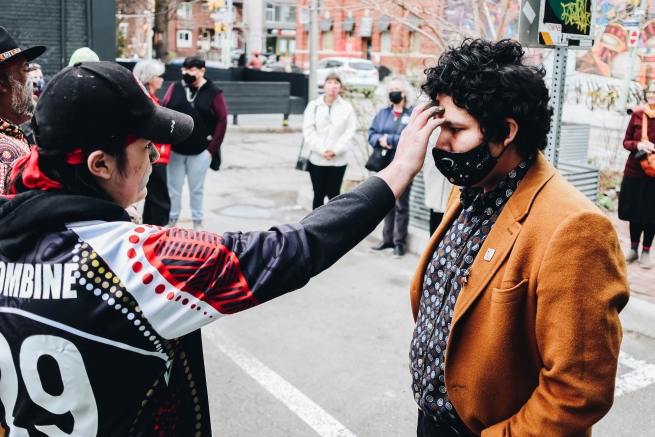
The Canadian Music Centre faces similar challenges. Since 1959, the national office—currently located a few kilometres from the Tranzac—has housed a library containing a vast catalogue of Canadian music. Historically serving a white-dominated classical music scene, the CMC’s board of directors recently established the Accountability for Change Council; a standing committee of board members and community advisors, the Council is tasked with addressing the systemic exclusion of marginalized communities from the centre’s activities.
Musicologist Jeremy Strachan—whose research and teaching interests include music and settler colonialism and decolonial methodologies within Canadian music—now sits on the Council. More than a decade ago, when he was a library assistant at the centre, he “made a repertoire guide of works inspired by Indigenous cultures,” he told me. The CMC was a different institution in 2005 when Strachan generated repertoire guides for patrons such as orchestra or ensemble managers. He observed frequent demands for music pertaining to the Canadian North; a list he made of music adhering to Indigenous themes included two hundred pieces, with descriptive titles like “Eskimo Lullaby,” “Variations on an Indian Tune,” “Legend of the Raven,” and “How the Loon Got Its Necklace.” Later, during his research into Indigenous–settler relations that were part of such music creation, he inevitably crossed paths with xwélmexw scholar and artist Dylan Robinson, who was the Canada Research Chair in Indigenous Arts at Queen’s University at the time. (Robinson is now Associate Professor at the University of British Columbia’s School of Music and Advisor to the Dean on Indigenous Arts.) Much of Robinson’s work examines, as he describe it, “the appropriation of Indigenous song in contemporary classical music, and artistic practices of repatriation and redress.” The three-act opera Louis Riel (1967), composed by Harry Somers with a libretto by Mavor Moore, recounts the controversial history of Métis leader Louis Riel, who was executed in 1885 on charges of treason. Robinson and two colleagues called out the “Kuyas” aria that opens Act Three as a misuse of a lim’ooy̓ (lament) of the Nisga’a nation in northwestern British Columbia, and demanded that it be withdrawn.
“This is by far the most public, noteworthy instance of addressing musical appropriation in Canada,” Strachan continued. “Conversations took years as the Nisga’a Lisims Government formally requested its removal.” (Marion Newman took part in negotiations between all parties concerned with this music.) After acquiring consent from stakeholders, the Canadian Opera Company and the National Arts Centre commissioned Métis composer Ian Cusson to write “Dodo, mon tout petit” (2019) as a replacement. Using Moore’s original French libretto, this aria served as redress to an act of cultural misuse.
Strachan then told me about Naačnaača (1975) by Latvian Canadian composer Tālivaldis Ķeniņš,” the basis for his chapter in the forthcoming Routledge Companion to Ethics and Research in Ethnomusicology. “I’m certain that Ķeniņš found a restricted Nuu-chah-nulth song and used it for a youth-orchestra commission,” said Strachan, who got in contact with the community’s cultural historian and played him the composition. “He knew the song and who exactly it belonged to.” (Noted linguistic and cultural anthropologist Edward Sapir—the first chief ethnologist for the Geological Survey of Canada’s Department of Anthropology from 1910 to 1925—conducted extensive field research with the Nuu-chah-nulth, formerly referred to by settlers as Nootka, of Canada’s Pacific Northwest Coast. Sapir recorded their songs on wax cylinder recordings, now in the Canadian Museum of History in Ottawa; transcriptions were published in 1955 by Helen Roberts and Morris Swadesh for the American Philosophical Society.)
The late R. Murray Schafer is also a problematic figure. “It’s terribly complicated,” Strachan explained. “Schafer’s music is omnivorous in interpreting not only Indigenous culture but also spirituality, ceremony, and ritual from all over the world.” Schafer was invested in humankind’s relationship to place and environment through performance, and simulated ways Indigenous peoples built their relationships with the land. His influence planted deep roots in sound studies, particularly in acoustic ecology. Besides the Patria music drama cycle (composed over forty years, beginning in 1966), Schafer also has the choral works Snowforms (1981) and Miniwanka (1971) that used Indigenous words for snow and water. An unpacking of the complicated nature of these compositions has yet to materialize in full view. Schafer’s death in 2021 brought an outpouring of tributes—out of thirteen compiled tributes in “Remembering R. Murray Schafer” by the Institute for Music in Canada, only composer Emily Doolittle and cultural worker Claude Schryer acknowledged this facet of his work; major media outlets did not mention it at all.
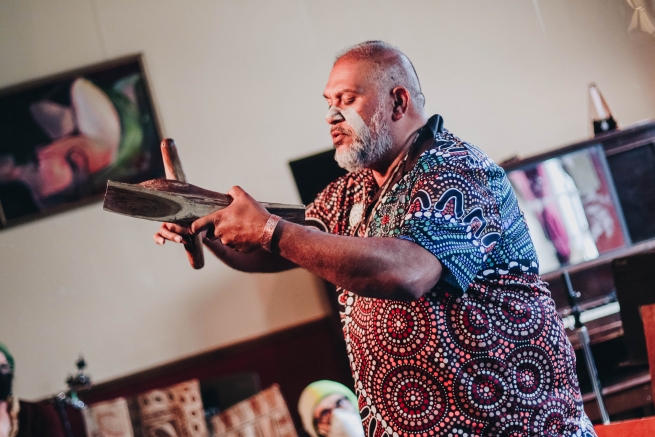
Attendees walking in single file pass through the smoke before entering the Tranzac. Students from the Centre for Indigenous Theatre join us, breathing in the smoke and bathing their hands in it. Now cleansed, everyone is welcomed into a sacred space. With ochre paints on our foreheads, we are one with the land. By bearing witness, we are welcomed as family.
In contrast, Canadian composers felt welcome to help themselves to songs without invitation. Newman explained: “[They] were taking Indigenous songs, thinking they were just folk songs that wouldn’t matter to anyone. They did this with express support of the government, who encouraged them to find a ‘Canadian’ sound.” In his book Hungry Listening: Resonant Theory for Indigenous Sound Studies, Dylan Robinson writes that composer Ernest Gagnon and his contemporaries partook in the “Canadian inheritance of Indigenous culture . . . [as] . . . artistic descendants of Indigenous people,” adding that Gagnon’s claims on Indigenous “roots” to define Canadian identity also preclude settlers “going native” in North America’s present times. Goombine told me that one of his seventh-generation grandfathers was the sole survivor of his clan during the raids of the first fleets claiming their stakes in Australia.
“We don’t think of our songs as possessions,” Newman said. Yet permissions from hereditary rights holders are required. “You may need to ask certain family members if you want to perform that song. Or a family would rise up during a potlatch ceremony, sing a song, and say, ‘We now give that to you.’” Songs themselves possess agency. “When others need to sing it, we check in with how the song would feel if somebody else sang it in a different setting.”
The Accountability for Change Council recently struck an independent Indigenous Advisory Council to “deal with the existing appropriated music in the CMC catalogue,” as described on the centre’s website. The council aims to offer a set of recommendations for Strachan’s repertoire list and future collaborations. As a non-Indigenous member, Strachan serves as the project manager who liaises monthly with the advisory council and the centre. Robinson and Newman serve on the council, alongside Indigenous musicians from across Canada.
Newman and Strachan both stated adamantly that the Indigenous Advisory Council is invested in conducting this initiative properly. As Strachan explained, “this will entail outreach to particular communities in many cases, because the council doesn’t want to speak on behalf of all Indigenous peoples.” Robinson’s leadership in negotiating the removal of “Kuyas” from Louis Riel reflects the work this council is doing. “You can imagine that with more than two hundred works it can literally take years.”
The act of redressing misappropriation often comes in the form of repatriating songs to their origin point. Museum glass enclosures are removed from songs that were collected during the decades when Canada was engaged in cultural genocide. Imagining compositions as glass houses reflects the violent nature of dispossessing Indigenous sovereignty over these songs.
“You gotta give it away to keep it.” Goombine’s—or rather, his grandfather’s—jarring words strike me.
“That’s the opposite of saying, ‘we have to protect our heritage!’” I say.
“Look, if we don’t pass down our knowledge of songs and ceremonies, the language, songs, dances, and stories will be lost. That’s how we can share who we are with the world,” he answers.
As Newman said, “If settlers arrived in North America with curiosity and respect, we could have walked together and learned about the land without taking too much from it.” Extractive practices in cultural production mimic the dynamics of colonization. “We don’t want [our songs] performed for entertainment,” she added. Settlers need to grapple now with what it means to own a song beyond Western notions of copyright.
Apprehension surrounds the advisory council’s initiative of redress. Strachan rattled off the kinds of questions that are coming from the music community: “What right do you have to make these determinations? Are you going to censure scores?” Newman told me, “Some are apparently afraid that we are going to cancel them.” The CMC has been taking great care to learn and see through the initiative. Policing the community is not the advisory council’s goal.
“Some people want to know how to connect to Indigenous culture and bring forth reconciliation,” Newman said. “Discussions are amazing opportunities to forge connections and learn from mistakes. I hope that composers and estates are willing to see it that way.”
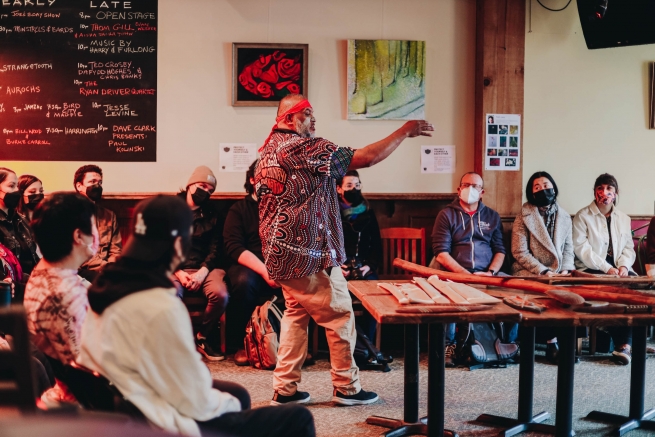
We find song and lore among Goombine’s arsenal for sharing his humanity. The emotional heaviness of a reunion with ancestral objects spills over during the ceremony that lasts an hour and a half. Goombine animates and honours these objects for those of us gathered in the Southern Cross Lounge.
He recalls the story of Tunku and Ngardi, the first humans upon whom Wandjina the Creator bestowed a tree and a rock—gifts which birthed the tools and weapons that govern Indigenous life. We learn about the giant Rainbow Serpent who awakened and carved the earth’s surface with mountains and rivers—as depicted on one of the boomerangs. A shield made of coral-tree wood bears painted circles and horseshoe curves; Goombine explains that they symbolize watering holes or ceremonial grounds and people, respectively.
“While they [colonizers] have the concept of taking, we have the concept of welcome, where we sing a song as a gift,” Goombine tells me. “We use tapping sticks, which carry the same representation as the drum. When we strike them together, we describe its sound as nadjung merryo—mother’s heartbeat.” And here we are, feeling a faraway land’s heartbeat as Goombine shares his songs, using tapping sticks from the collection. These objects were created for functional use, not for display.
As the event winds down, Goombine gives the Tranzac a wooden shield carving from the collection as a memento of its relinquishing the objects and to embody the family ties, kinship, and cooperation between him, the Tranzac, and the witnesses. The remaining items will later be returned to Goombine’s homeland.
With this ceremony, Goombine personally imparts two life lessons to me. The first goes like this: “For them, the world runs in numbers. For us, the world runs in circles.” It reminds me of that wooden shield with the painted circles. “What does the earth do?” he asks me.
“It turns around,” I reply.
“What does the solar system do?”
Same thing. Then I ask, “So it’s like saying that what goes around, comes around?”
He laughs heartily at that suggestion.
He picks up a stick from a barren tree. “What does this stick look like? Looks dead?”
I shrug.
“But it’s not. You rub two sticks together, and it comes alive again. It still has its journey; you never look at anything as dead.” I remember the hidden ancestral objects, their journeys that will now continue beyond the dark closet. The fifty-three-year-old koto (similar to a zither) I bought in Japan comes to mind; my mentor urged me to keep playing it to keep its voice alive: “If you neglect it and throw it away, the koto dies. The craftsmanship in making that instrument will die along with it.”
Artists are beginning to respect the spaces that songs inhabit. They are not meant to be enclosed in glass cases. They have agency. They transform themselves, and the richness of the stories they carry, as people pass them along. Goombine passes on this story with permission, and I now recount what I have seen and heard. While we repatriate objects and songs to enact a resequencing of past wrongdoings, they are also intended to resonate for all those who hear them.
LINK: Marion Newman dons her dramaturge hat to develop a new opera, Namwayut, with the support of Calgary Opera. It’s a unique collaboration of singers, composers, a librettist, and musicians that celebrates the resilience of Indigenous peoples and their connection to the land. Learn more.
FYI: Dylan Robinson calls for redress and greater responsibility among composers and music creators on appropriating Indigeneity in “Ethnographic Redress, Compositional Responsibility,” which is a chapter in Hungry Listening: Resonant Theory for Indigenous Sound Studies (2020, University of Minnesota Press). Learn more.
